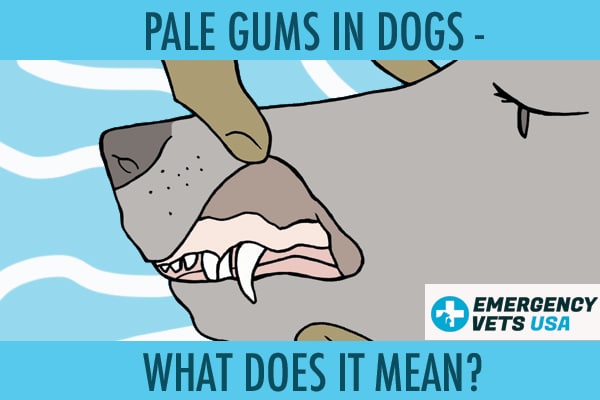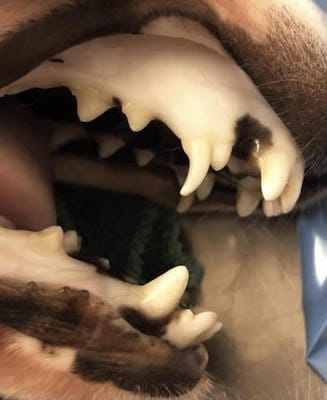Pale Gums In Dogs – What Does It Mean?
Are your dog’s gums pale or white in color?
The color of your dog’s gums can offer you a peak into their current state of health.
With pink gums being the optimal color of these mucous membranes, anything different can warrant an immediate phone call to your veterinarian.
So what medical conditions can cause pale gums in our canine friends?
In this article we will go into the potential causes of your dog’s pale gums, and help you better understand what these complications can mean for your pup going forward.

What Is A Normal Gum Color In Dogs?
No matter what type of furry friend you have in your home, they should all have pink gums that are moist to the touch.
Their gums are filled with hundreds of tiny blood vessels just under the surface, leading to the salmon to peach color shade that you typically see.
While some dogs will have additional pigmentation or mottled gums, you will typically find the occasional pink spot somewhere throughout their mouths.
How Do You Know If Your Dog Has Pale Gums?
Thankfully for our canine companions, it’s easy and pain free to check the color of their gums.
By simply lifting their lips and assessing the color of the tissue above the teeth, you can easily determine the shade of pink you see.
It can be more challenging to find the pink mucous membrane in a dog with tongue and gum pigmentation, but you should find the occasional pink spot on their gums or throughout their cheek tissue.
We suggest checking your dog’s gum color a few times a month to simply get a feel of the color that is normal for your pup.
This can help you better determine when something is off, allowing you to make that phone call to your vet when needed.
How To Check Your Dog’s CRT (Capillary Refill Time)
Not only is your dog’s gum color an important indicator of their current health, but so is there capillary refill time (CRT).
A dog’s CRT refers to the time it takes the color to return to the gums after blanching (pressing on) the area.
The standard CRT for dogs is typically 1-2 seconds, with anything outside of this range pointing to the potential of underlying illness or dehydration.
When you check your dog’s capillary refill time, you should also assess how moist the gum’s are.
If the gums appear tacky or if your finger sticks to the gums periodically, this can be evidence of dehydration.
If you ever notice an abnormal CRT or dry gums in your furry friend, we suggest reaching out to your veterinarian for further guidance.
Symptoms Associated With Pale Gums In Dogs
If you think your dog may have pale gums, there are other symptoms to be on the lookout for as well.
It’s important to keep in mind that these signs can be present with or without any change in gum color, but they should always warrant a trip to your veterinarian.
- Lethargy
- Weakness
- Anorexia
- Labored breathing
- Panting
- Easily winded
- Increased heart rate
- Vomiting
- Diarrhea
- Blood in urine, vomit, or diarrhea
If you notice any of the above symptoms in your dog, we suggest reaching out to your veterinarian immediately.
Even if they do not have pale gums, these symptoms require urgent attention.
What Causes Pale Gums In Dogs?
When you take your dog to the vet for their pale gums, there are typically a few common conditions that your vet may be suspicious of.
To help you better understand the medical conditions your vet will attempt to rule out, let’s discuss some of the most common causes of pale gums in dogs below.
Anemia (Hookworm Anemia)
Anemia is a serious medical complication that is known to cause pale gums in dogs.
The term anemia refers to a decrease in circulating red blood cells within the bloodstream, making it challenging for the body to transfer oxygen to the different organ systems.
While anemia is a diagnosis in itself, it is typically a result of some other underlying illness causing the loss of red blood cells.
Some of the most common causes of anemia in dogs include, hookworms, other intestinal parasites, fleas, autoimmune disease, blood parasites, and even toxins.
Due to the many potential causes of anemia in our pups, you can expect your vet to perform multiple diagnostics in search of an answer.

Blood Loss
Blood loss is another potential cause of pale gums in our furry friends.
Significant blood loss can lead to a decrease in circulating red blood cells within the body, as well as the onset of shock due to this sudden change.
While most of us will associate blood loss in dogs with trauma, that’s not always the case.
Some of the most common causes of blood loss in dogs include lacerations of the skin, internal trauma, intestinal parasites (due to bleeding in the intestines), intestinal ulcers, and bloody diarrhea.
If the cause of your dog’s blood loss is not related to an obvious trauma, you can expect them to perform multiple diagnostics to get to the root of their symptoms.
Dehydration
Dehydration can also lead to pale gums in some canine companions.
Though you may not see the typical white gums you would see with significant anemia, the gums can certainly sport a pale pink appearance once a dog becomes severely dehydrated.
Not only can you notice a change in gum color, but the gums may also be tacky to the touch.
Dehydration is not often a diagnosis in itself, but rather a side effect of an underlying illness leading to fluid loss.
Some of the most common causes of dehydration in dogs include vomiting, diarrhea, anorexia, and chronic illness.
If you think your pup may be dehydrated, it’s time to reach out to your vet for further guidance.
Shock
If a dog is in shock for any reason, they may experience pale pink or pale gums.
A dog that is in shock is experiencing an inadequate supply of blood flow circulating throughout the body, making it challenging for the organs to be supplied with oxygen.
Shock is a life threatening side effect of an underlying cause, ranging from sudden trauma to allergic reactions.
Some of the most common causes of shock in dogs include anaphylactic reactions, severe dehydration, trauma, blood loss, sepsis, and toxicity.
Shock in dogs requires immediate medical attention no matter the underlying cause, which is why it’s so important to take your dog’s pale gums seriously.
Kidney Disease
Dogs in the later stages of kidney disease may develop pale gums due to anemia.
The kidneys are responsible for producing the hormones that stimulate red blood cell production, so a decrease in kidney function can often lead to anemia as a result.
You may begin to notice pale gums as your dog’s kidney disease progresses, but this can also be the result of dehydration from the condition.
If you ever notice pale gums in your dog with kidney disease, we suggest reaching out to your vet for further guidance.
Your vet can perform diagnostics to keep up with the progression of their condition, and alter any treatment plan that is currently in place.
Respiratory Distress
Pale gums can develop if your dog is experiencing respiratory distress for any reason.
While your pup may also develop muddy or blue tinged gums as their respiratory distress progresses, pale gums can not be ruled out.
A dog with respiratory difficulty may also experience labored breathing, panting, weakness, distress, elevated heart rate, and even collapse.
If you think your dog is having a hard time breathing, it’s imperative that you contact your veterinarian immediately.
Respiratory distress is one of the most severe emergencies that our dogs can experience, so it will always require immediate medical intervention.
Diagnosing Pale Gums In Dogs
As you can see, pale gums in dogs can develop as a result of multiple underlying conditions.
Due to this, your vet may need to perform multiple diagnostics in order to develop an accurate treatment plan for your dog’s needs.
Unless your dog has an obvious ailment that can be seen on a physical exam, you can expect your veterinarian to suggest the following:
- CBC & chemistry blood panel
- PCV & total protein
- Radiographs
Even if the cause of your dog’s pale gums is noticeable on exam, your vet may still perform diagnostic blood work to obtain the true values of their blood cell count and organ function.
This will not only help your vet determine the best plan of action going forward, but it will also help them track your dog’s progress as their treatment is implemented.
Treating Pale Gums In Dogs
The exact treatment plan for your dog’s pale gums will vary based on the underlying condition that has led to their pale mucous membranes.
Your dog may require IV fluids to reverse shock, a blood transfusion to replenish a low RBC count, deworming treatment to fight intestinal parasites, and anything in between.
Your vet is the only one that will have a full understanding of your dog’s situation, so it’s best to trust their guidance when determining the best treatment plan.
Performing all recommended diagnostics is also the best way to accurately treat your dog’s underlying condition.
Final Thoughts
Pale gums in dogs can be an indicator that it’s time to reach out to your veterinarian for medical care.
Due to the many underlying conditions that can cause pale gums in our furry friends, we always suggest taking this symptom seriously.

My name is Amber. I am a dedicated animal lover that turned my passion into my career. I am a Licensed Vet Tech with 12 years of experience in veterinary medicine, but I recently took my career online to help spread accurate information on animal care. With how vast the online world is, I have a strong desire to ensure that the reader always walks away with helpful pet advice. With the experience I’ve gained from my time in this field, I have been able to travel the world, offering my services to as many animal rescues as I can find. If I am not at my laptop, or back home visiting family, you can find me somewhere in the world, cuddling every furry friend that I can find! More About Us
